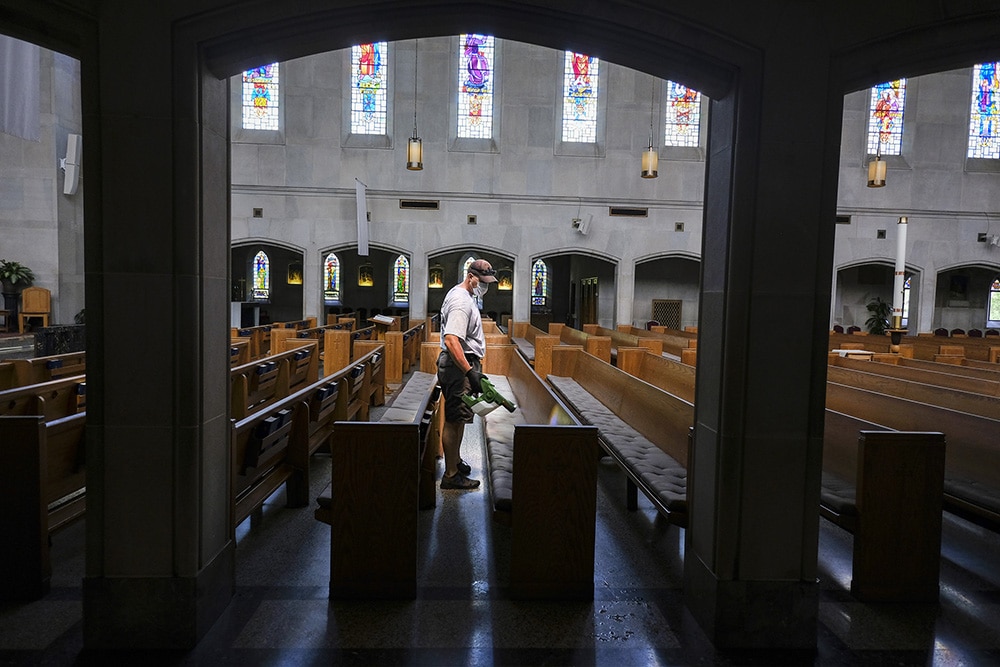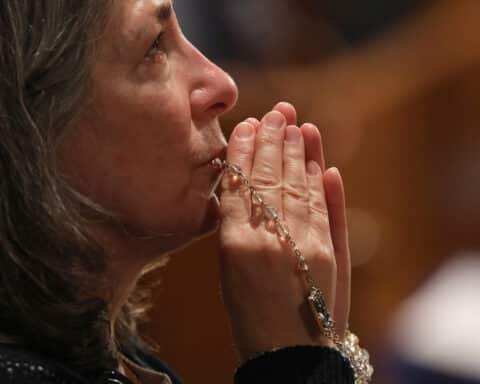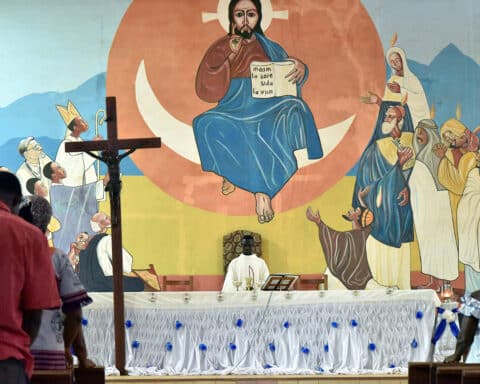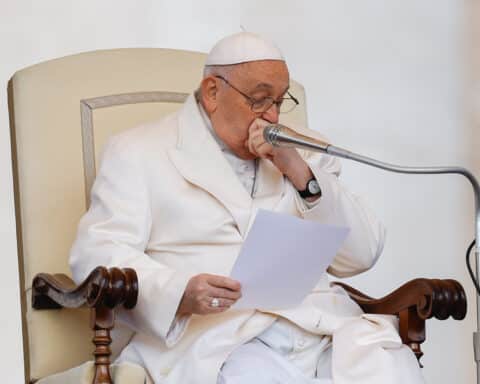The feast of St. Joseph, March 19, was the last day for public Masses in any diocese in the United States before all residents were recommended to shelter in place and avoid “nonessential activities.” For the last nine Sundays, my wife, five youngest children (including two finishing college years at home) placed a semicircle of chairs in front of a television and participated in Mass virtually. Each of us fervently prayed the spiritual communion during the appropriate part of Mass. It was refreshing to get in the “Catholic calisthenics” of sitting, standing and kneeling during the parts of the Mass, and that reinforced something I learned years ago — that “as the body is inclined, so is the spirit.” In other words, a position of bodily humility lends itself to spiritual humility.
But it wasn’t the same as attending Mass at a parish. And to add insult to injury, during the early spring, state and national debates about what activities are essential vs. nonessential dotted the media landscape, and it seemed that our beloved Catholic Mass was somehow deemed nonessential. What could be more essential than worship of — and union with — the one who created us, loves us and sustains us? If I ever thought that attending Mass was a duty, it is now clear to me that it is a gift — a gift that I need to become the best version of myself, the version that God created me to be.
A longing to return
Instead of asking what activities are essential or nonessential, the better question to ask amid this pandemic is this: “How can we participate in activities — especially the Mass and reception of the sacraments — safely with the lowest possible risk for acquiring infection?”
Answering this question has guided the efforts of the Thomistic Institute Working Group on Infectious Disease Protocols for Sacraments & Pastoral Care. I share the belief with my fellow members that not only is the Mass essential to our lives as Catholics, but it also can be done in a safe manner during the COVID-19 pandemic. In fact, the purpose of the working group is to provide guidelines that follow the recommendations of the Centers for Disease Control and Prevention and the legally binding requirements of various state departments of health.
These guidelines were prepared to offer bishops and priests ways in which they could adapt the public health requirements of their states — and the recommendations of the CDC — to safely resume public Masses.
I am thrilled that I will get to return to Mass in my diocese for the celebration of the Ascension! Some will likely have to continue waiting, while many of you have been able to return even sooner, and you have probably found things a little different at your churches. All these things are being done to reduce the risk of spreading COVID-19 (especially if we are unaware that we have it) or contracting it from others.
The guidelines provide ways for Mass to take place safely, and I believe that if they are followed, the risk of acquiring COVID-19 at Mass is very low. To keep this risk low, anyone with respiratory symptoms such as a cough, frequent sneezing, sore throat — or feeling sick in any way — should stay home. This is not the time to “muscle through” attending church by offering up your sickness at a public Mass.
Many devout Catholics who intensely miss participating in public Masses are over the age of 65. If I were in that group, I would certainly be lining up at the door for the first available Mass! Risks from COVID-19 are higher for people over 65, so they should remember that they are not obliged to come to Mass. Of course, many in this group intensely desire to return to Church and might find it especially difficult to stay home from Church longer than they have. If they decide to come, it would be wise to take extra care with physical distancing.
Stopping the spread
When you arrive at the Church, there may be ushers holding the doors open for you so you don’t need to touch door handles. But if you do touch the handle, hand sanitizer at the entrance can be used immediately after entering.
To achieve 6 feet of space between nonhousehold members, every other pew is being blocked off. In this manner, churches likely will accommodate 25-40% of normal capacity and offer extra Masses to compensate for the smaller crowds. In our diocese, the bishop is allowing priests to celebrate up to four Masses each Sunday to accommodate the faithful, and I find this incredibly generous.
None of us wants to spread infection to another person, and 50-80% of people with COVID-19 infections have no symptoms — they don’t know they have it! One of those people could be you or me. To make Mass even safer, many bishops are asking us to wear cloth face coverings at Mass so that we don’t unwittingly spread an infection to someone else. If my bishop asks me to wear a face covering to attend Mass and receive Jesus’ body and blood, soul and divinity, it’s a small price to pay. Cloth face coverings work best with hand hygiene, which is why some bishops are recommending unobtrusively using hand sanitizer or sanitizing wipes in the pew right after removing face coverings to go to Communion. That way, the benefits of wearing the face coverings are not defeated by touching them.
I find that if I remember that the reason for my actions is primarily to protect others, then it is relatively easy to accept the minor inconveniences of wearing a face covering, using hand sanitizer and sitting farther apart from nonhousehold members. And, by the way, there is no benefit to wearing gloves at Mass; hand hygiene with sanitizer is sufficient.
Singing at Masses will be discouraged at this time because of events like the high profile report of a singing super-spreader at a choir rehearsal. On March 10 in Skagit County, Washington, 53 of 61 socially distanced choir members contracted COVID-19 during one rehearsal. None of the choir members had symptoms of illness during the rehearsal. Singing projects respiratory droplets much farther than speaking.
Guidelines for Communion
The guidelines allow for safely receiving holy Communion on the tongue or in the hand. Many bishops are asking their faithful to receive in the hand for the time being because the virus is present in high concentration in the saliva of infected individuals. For that reason, receiving Communion on the tongue poses a higher risk to the extraordinary minister of holy Communion than does receiving Communion in the hand if the minister accidentally touches the tongue compared to the hand. The ministers are recommended to sanitize each time they sense they have touched a communicant.
According to the CDC, there are no reports of food-borne COVID-19 infections. This should help the faithful feel more confident about the safety of receiving holy Communion. For the time being, my family will now receive Communion in the hand (instead of our normal habit of receiving on the tongue) out of concern for our pastor’s safety.
How long, O Lord?
What about bringing young children to Mass? As a father of seven children, my wife and I have passed through the years of young children not being able to sit still at Mass. The guidelines’ only comment about children is not to put a face covering on a child under age 2 since it would be difficult to safely keep in place. Perhaps a practical way to look at bringing young children to Mass would be to ask if they can be trusted to sit in place and not wander off and touch other people. If they cannot do this, it might be best to split Mass attendance between spouses and bring only those children old enough to sit in place during Mass. Remember, the bishops have removed the obligation to attend Sunday Mass so that we don’t have to scruple over questions such as this.
Dismissal from Masses usually will be by rows to keep from crowding in the aisles. After Mass, it will be great to socialize with others — with that 6-foot distance. Chances of spreading or contracting COVID-19 drop dramatically outdoors, so enjoy talking to your friends after Mass!
And finally, that question we all want answered: How long, O Lord, how long? While I would love to know the future, I can’t tell you how long these changes at Mass will last. Our public health officials, who are doing the best that they can with the data and knowledge they have, will let us know when our former normal activities become safe again. Until then, we can say with the psalmist, “I rejoiced when they said to me, / Let us go to the house of the Lord!” (122:1).
Dr. Thomas McGovern practices Mohs surgery and reconstruction in Fort Wayne, Indiana. He formerly performed infectious disease research at the U.S. Army Medical Research Institute of Infectious Diseases, serves on the national board of the Catholic Medical Association and is a member of the Thomistic Institute Working Group on Infectious Disease Protocols for Sacraments & Pastoral Care.





